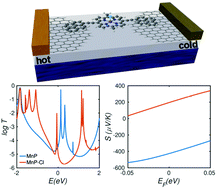Discriminating Seebeck sensing of molecules†
Abstract
One of the fundamental challenges in molecular-scale sensors is the junction to junction variability leading to variations in their electrical conductance by up to a few orders of magnitude. In contrast, thermal voltage measurements of single and many molecule junctions show that this variation in the Seebeck coefficient is smaller. Particularly, the sign of the Seebeck coefficient is often resilient against conformational changes. In this paper, we demonstrate that this robust molecular feature can be utilised in an entirely new direction of discriminating molecular sensing of gas and bio-molecules. We show that the positive sign of the Seebeck coefficient in the presence of cytosine nucleobases changes to a negative one when cancerous cytosine nucleobases were absorbed on the molecular wire formed by metalloporphyrins. Furthermore, the sign of the Seebeck coefficient changes when chlorine gas interacts with the Mn-porphyrin molecular wire. The change in the sign of Seebeck coefficient is due to the formation of spin driven bound states with energies close to the Fermi energy of electrodes. Seebeck sensing is a generic concept and opens new avenues for molecular sensing with huge potential applications in the years ahead.



 Please wait while we load your content...
Please wait while we load your content...